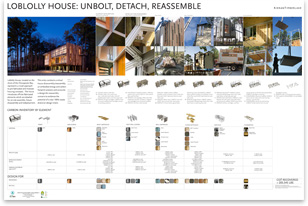Sustainability
Rise to the Lifecycle Building Challenge!
by Michael J. Crosbie, PhD, AIA
Contributing Editor
 Summary: It’s all about waste. And the Lifecycle Building Challenge is looking for your ideas, designs, and projects for lightening the load that architecture and building has on Earth’s resources and landfills. LBC is an awards program that recognizes constructed and unbuilt projects that demonstrate the goals of lifecycle design and construction. Registration for the program opens in March, and entries are due in August. Summary: It’s all about waste. And the Lifecycle Building Challenge is looking for your ideas, designs, and projects for lightening the load that architecture and building has on Earth’s resources and landfills. LBC is an awards program that recognizes constructed and unbuilt projects that demonstrate the goals of lifecycle design and construction. Registration for the program opens in March, and entries are due in August.
The program grew out of a single project, the Chartwell School in Seaside, Calif., designed by EHDD Architecture, which was the first school in the country to receive a LEED® Platinum rating. The design incorporated a number of strategies for recycling, and inspired the LBC awards program.
 AIA is a partner AIA is a partner
The AIA is a partner in LBC, which is supported by the Environmental Protection Agency, with which the Institute signed a memorandum of understanding in 2006 to support recycling efforts and improve the environmental performance of buildings. EPA has a number of issues that architects should keep in mind when designing to reduce waste. Specifically, targets call for diverting or reducing construction and demolition waste to preserve land, reduce water generation, and increase recycling. The goal, which is part of the EPA’s strategic plan, is to increase reuse and recycling of construction and demolition debris by 6 percent over 2003 levels by the year 2011.
What distinguishes architecture that promotes lifecycle building and reduces waste? LBC describes it as “designing buildings to facilitate disassembly and material reuse to minimize waste, energy consumption, and associated greenhouse gas emissions.” It also recognizes design for disassembly and deconstruction, to the extent that buildings constructed for today are seen as stockpiles of materials and resources for construction in the future. This is a fairly radical way of looking at the built environment. It requires the architect to consider the design of not only the current building, but the one after, and the one after that.
What objectives should the architect strive for in lifecycle design? LBC offers a number of targets. Design should encourage local building material reuse (so that disassembly and reconstruction does not require transporting materials long distances). Architects should also think about maximum material recovery, in terms of how the building comes apart after assembly, allowing materials to be extracted efficiently. Reducing embodied energy and greenhouse gas emissions is another goal, as is decreasing environmental and economic costs. If you are still getting up to speed on how to accomplish these goals, the LBC Web site offers a great resource page that will point you in the right direction for case studies, reports, examples, and projects.
 Wide range of good ideas Wide range of good ideas
The LBC awards program encourages projects submitted by persons involved in the design and construction of architecture, recycling, building product design, and other aspects of creating the built environment. Last year’s winners reflect the wide spectrum of work that LBC recognizes. Group 41 Architects won for its design of a housing system based on the reuse of shipping containers. Kieran Timberlake’s Loblolly House won for its inventive use of materials that can easily be unbolted, disassembled, and inserted back into the construction material stream for future projects. Architecture students at the University of Illinois won for their design of a prefabricated and demountable “Transient Awareness Center” to provide information to local residents. Busby Perkins + Will won for its assessment study of a 1960 university building to determine how to disassemble the building and reuse its materials.
For more information about the Lifecycle Building Challenge, and the awards program, visit the LBC Web site. The site will post entry guidelines in March and currently has profiles of the 2007 and 2008 award winners, plus lots of information and other resources on designing for recycling and reuse. |


 Summary:
Summary: AIA is a partner
AIA is a partner Wide range of good ideas
Wide range of good ideas